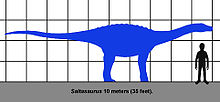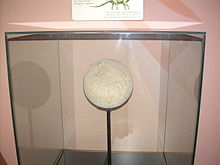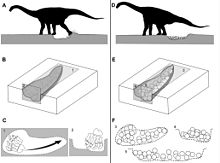- Saltasaurus
-
Saltasaurus
Temporal range: Late Cretaceous, 70 Ma
Restoration Scientific classification 
Kingdom: Animalia Phylum: Chordata Class: Reptilia Superorder: Dinosauria Order: Saurischia Suborder: †Sauropodomorpha Infraorder: †Sauropoda Branch: †Titanosauria Family: †Saltasauridae Genus: †Saltasaurus
Bonaparte & Powell, 1980Species: †S. loricatus
Bonaparte & Powell, 1980Saltasaurus (which means "lizard from Salta") is a genus of titanosaurid sauropod dinosaur of the Late Cretaceous Period. Relatively small among sauropods, though still massive by the standards of modern creatures, Saltasaurus was characterized by a diplodocid-like head (with blunt teeth, only in the back of the mouth). It was the first genus of sauropod known to possess armour of bony plates embedded in its skin. The small bony plates (called osteoderms, a feature of modern crocodiles) have since been found on other titanosaurids. When the plates of a saltasaur were originally found, independently of skeletal remains, they were assumed to be from an ankylosaurian, whose plates they resemble. A crest of scutes has also been discovered running down the back of diplodocid sauropods.
Contents
Description
Saltasaurus was first described by José Bonaparte and Jaime E. Powell, in 1980 and had an estimated length of 12 metres (39 feet) and a mass of 7 tonnes (8 tons). Like all sauropods, Saltasaurus was herbivorous, and its name is derived from the region of north-west Argentina, where the first fossils were recovered. Other fossils have since been found in Uruguay.
There is currently only one known species of Saltasaurus, S. loricatus, as S. australis is now considered to belong to a separate genus, Neuquensaurus. The fossils of Saltasaurus include vertebrae, limb bones and several jaw bones — plus various pieces of armour. Some of these plates appear to have spikes as well, but there is not enough evidence available to be certain. All known specimens were found in the Lecho Formation of Argentina, dating to the Campanian or Maastrichtian stage of the upper Cretaceous period.
The vertebrae from the middle part of its tail had elongated centra.[1] Saltasaurus had vertebral lateral fossae that resembled shallow depressions.[2] Fossae that similarly resemble shallow depressions are known from Malawisaurus, Alamosaurus, Aeolosaurus, and Gondwanatitan.[2] Venenosaurus also had depression-like fossae, but its "depressions" penetrated deeper into the vertebrae, were divided into two chambers, and extend farther into the vertebral columns.[2]
Saltasaurus had more robust radii than Venenosaurus.[3]
Changing perceptions
In the Cretaceous Period, sauropods in North America were no longer the dominant group of herbivorous dinosaurs, with the duck-billed dinosaurs, such as Edmontosaurus becoming the most abundant. However, on other landmasses such as South America and Africa (which were island continents much like modern Australia) sauropods, in particular the titanosaurs continued to be the dominant herbivores. (See also: allopatric speciation.)
Saltasaurus was one such titanosaur sauropod, and lived around 70 million years ago. When it was first discovered, in 1980, it forced palaeontologists to reconsider some assumptions about sauropods as Saltasaurus possessed crocodile-like armour (osteoderms) 10 to 12 centimetres (4 to 5 in) in diameter. Previously, it had been assumed that size alone was sufficient defence for the massive sauropods. Since then, palaeontologists have investigated the possibility that other sauropods may also have had armour; for example, the Argentinian Laplatasaurus.
Eggs
A large titanosaurid nesting ground was discovered in Auca Mahuevo, in Patagonia, Argentina (another titanosaur nesting site has reportedly been discovered in Spain). Several hundred female saltasaurs dug holes with their back feet, laid eggs in clutches averaging around 25 eggs each, and buried the nests under dirt and vegetation. The small eggs, about 11–12 cm (4–5 in) in diameter, contained fossilised embryos, complete with skin impressions showing a mosaic armour of small bead-like scales.[4] The huge number of individuals gives evidence of herd behavior which, along with the armour, could have helped provide protection against contemporary predators such as Abelisaurus.[5]
In popular culture
Saltasaurus appeared in the 4th episode of the Discovery Channel series Dinosaur Planet.
Footnotes
- ^ "Caudal Vertebrae," Tidwell, Carpenter, and Meyer (2001). Page 145.
- ^ a b c "Caudal Vertebrae," Tidwell, Carpenter, and Meyer (2001). Page 147.
- ^ "Forelimb," Tidwell, Carpenter, and Meyer (2001). Page 148.
- ^ Coria and Chiappe (2007).
- ^ http://www.plosone.org/article/info:doi/10.1371/journal.pone.0010362
References
- Coria, R.A. and Chiappe, L.M. 2007.Embryonic Skin From Late Cretaceous Sauropods (Dinosauria) of Auca Mahuevo, Patgonia, Argentina. Journal of Paleontology v81(6):1528-1532 DOI: 10.1666/05-150.1
- Tidwell, V., Carpenter, K. & Meyer, S. 2001. New Titanosauriform (Sauropoda) from the Poison Strip Member of the Cedar Mountain Formation (Lower Cretaceous), Utah. In: Mesozoic Vertebrate Life. D. H. Tanke & K. Carpenter (eds.). Indiana University Press, Eds. D.H. Tanke & K. Carpenter. Indiana University Press. 139-165.
Further reading
- Walking on Eggs: The Astonishing Discovery of Thousands of Dinosaur Eggs in the Badlands of Patagonia, by Luis Chiappe and Lowell Dingus. June 19, 2001, Scribner. ISBN 0-7432-1211-8.
External links
- Sauropodomorpha: Titanosauridae: 'Saltasaurus, by M. Alan Kazlev, from Palæos.
- The late Cretaceous nesting grounds of Patagonia, by Luis V. Rey, from his art gallery.
Categories:- Titanosaurs
- Dinosaurs of South America
- Cretaceous dinosaurs
Wikimedia Foundation. 2010.



